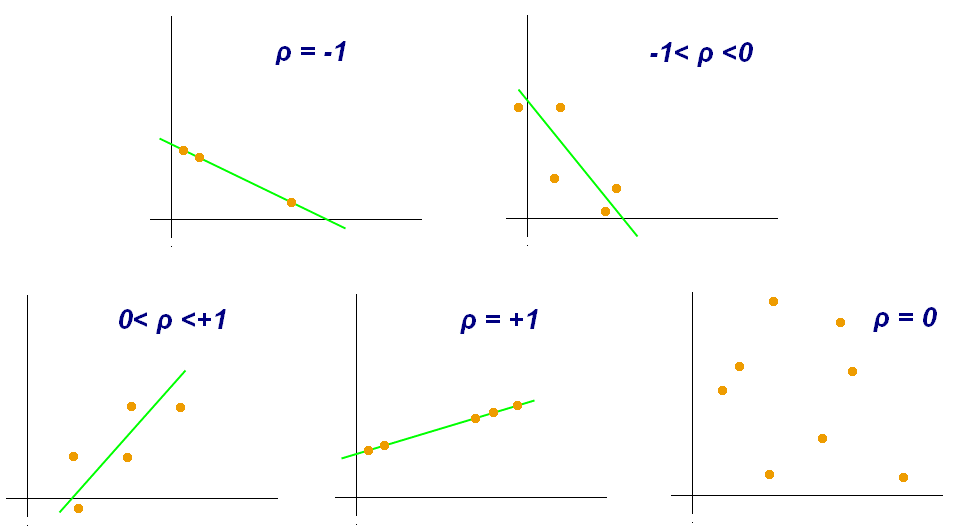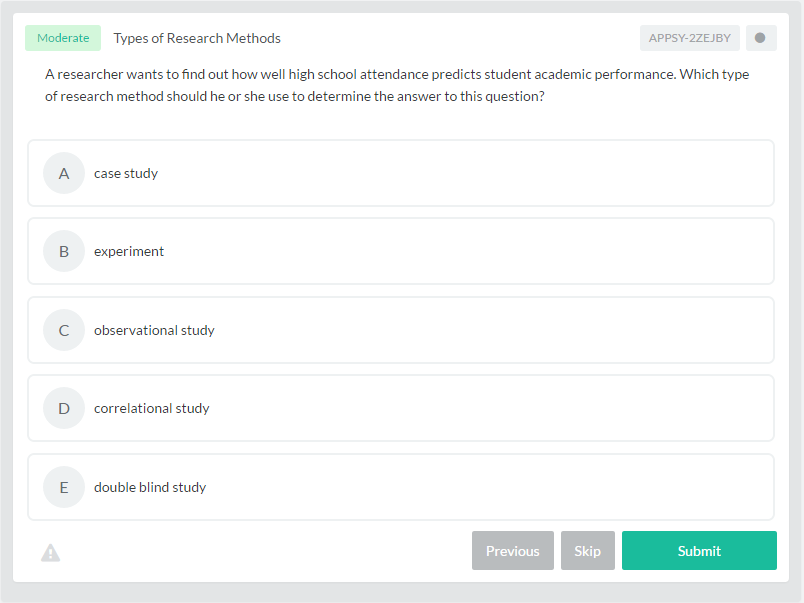Do you remember what a correlational study is? Knowing the main types of psychology research is a key point for the Advanced Placement (AP) Psychology exam as it makes up for 8-10% of the content in the multiple choice and free response questions. However, understanding the characteristics, advantages and disadvantages of each research method is only half of mastering this subject. The other half is understanding in concrete and practical terms how the research methods have been applied to studies in different fields of psychology. In this AP® Psychology crash course review, we will see three correlational study examples that have contributed to the history of psychology, changing the way we perceive our nature, our personality, and our health.
Review: What is a Correlational Study and why is it Important?
Psychology is a science, and like any other, its knowledge must be scientifically obtained, verified and validated. For this, psychologists conduct three types of research:
- Experimental research– the most empirical type of research, where variables can be manipulated in laboratory conditions and different situations can be studied and compared to establish relations of cause and effect between variables.
- Clinical research– done through case studies under the premise that certain individual characteristics can be generalized to the rest of the population.
- Correlational research – seeks the relationship between two variables. The necessary data is gathered through surveys (questionnaires and interviews), archival research (past studies that present the data) and naturalistic observation (observation of the phenomena as they naturally happen, without intervening). The data is then statistically analyzed to verify the relationship between the variables.
The correlation between the variables is shown through a value that goes from -1.00 to +1.00. This value is called the correlational coefficient. When the correlational coefficient is close to +1.00, there is a positive correlation between the variables. In other words, an increase in X accompanies an increase in Y. When the correlational coefficient is close to -1.00, there is a negative correlation between the variables or an increase in X is followed by a decrease in Y. And when the correlational coefficient is close to 0.00 there is no relationship between the variables. The closer the value is to +1.00 or -1.00, the strongest the relationship is. We will see real examples of this later on this post.

Now, the most important thing to remember about correlational studies is that correlation does not imply causation. For example, let’s say that “marriage” has a negative correlation with “cancer,” meaning that people who are married are less likely to develop cancer throughout their lives than those who remain single. This doesn’t necessarily mean that one causes the other or that marriage directly avoids cancer. Maybe one variable does cause the other, but even if it does, in correlational studies it is not possible to determine the direction of causation or what is causing what. And it could also be that a third unknown variable is what causes the correlation. Keep this in mind as we see the correlational study examples.
You might be wondering: if correlational studies only show this – correlations – why are they important in the first place if you could just conduct an experiment manipulating the relevant variables and getting to more solid conclusions?
Indeed, the disadvantages of correlational studies are that they cannot establish causal relationships nor direction of causal influence, there is no control of the variables, they don’t explain behavior, and they could result in illusory correlations. Illusory correlation is when there is a perceived relationship between variables that does not exist, like “a higher ice cream consumption leads to higher crime rate.”
On the other hand, one of the main advantages of a correlational study is that it is a useful way to describe and analyze data especially in cases where experimental research would lead to ethical issues. Take for instance a research that aims to investigate the relationship between child abuse and coping abilities later in adulthood. You obviously can’t take a random group of healthy children and expose them to abusive or traumatic situations to compare it with a control group. In the earlier stages of psychology, researchers could get away with teaching a phobia to a baby or leading participants to think they had electrocuted someone to death and get away with it in the name of science. Such practices are no longer acceptable, and correlational studies play an important role in developing knowledge in psychology.
Other advantages are that correlational studies are usually less expensive and easier to conduct than experiments and they allow for general predictions. They can also represent the first steps in a new field of research, leading to further studies and advances.
Now that you’ve reviewed the main concepts of correlational studies and why they matter, let’s see three important research examples in different fields of psychology and understand how all of this comes to life!
Study #1: Biological Basis of Behavior – A Debate on Nature Versus Nurture
We can easily think of how our genetics influence physical traits like height, hair and eye color. But have you ever considered that your genetics might also play a big role on psychological traits like personality and interests? In 1990 psychologists Thomas Bouchard, David Lykken, and their associates investigated the influence our genes have in psychological attributes. This was hard research to accept at the time considering that for the past fifty years, psychology was mainly focused on behaviorism and how the environment determines behavior. Bouchard and Lykken’s study brought the debate of nature versus nurture back to the spotlight, determined to clarify the genes’ and the environment’s role in who we are.
For this, Bouchard and Lykken conducted a study with monozygotic twins (identical twins) who had been separated at birth and raised in different environments and compared the results with identical twins who had been raised together. Note that this is a study in which one couldn’t simply replicate the situation in laboratory conditions, so a correlational study was the best way to analyze the data of real individuals in this situation.

Bouchard and Lykken gathered a huge amount of data from each pair of twins. They used a variety of personality trait scales, aptitude and occupational interest inventories, intelligence tests, family environment scales and interviews. At the end of the first part of the research, Bouchard and Lykken had information concerning the twins’ physiological traits, intelligence, personality, psychological interests and social attitudes. Next, Bouchard and Lykken analyzed the correlation between the twins in all these fields.
The results were surprising. If the environment were responsible for individual differences, identical twins reared together should be more similar than identical twins reared apart. However, that was not what the results showed. Both categories of twins had a very similar correlational coefficient that neared +1.00. This means that regardless of having being raised in the same or different environments, each person was very similar to his twin in all traits.
Based on this we can say that genetic factors strongly influence human behavior in a variety of ways, both physiological and psychological. This could be seen as a problematic conclusion since we like to put so much importance on environmental factors like education and parenting as if that alone determined who we grow to be, what interests we develop, what careers we choose and so on. However, it is not the case for giving up on all our efforts in life thinking that eventually the genes will just take over and determine our fate.
Bouchard and Lykken emphasize that although intelligence is mainly determined by genetic factors, it can still be enhanced by experiences. Approximately 70% of intelligence is genetically determined, which means there is still 30% that can be worked on or ignored in the environment, either at home with parents or at school with teachers and mentors.
The same can be applied to the other traits. For example, even if your genes hold a natural strength towards communication skills, none of it will matter if you don’t get an opportunity in your environment to make that skill emerge and develop. Recent research on identical twins shows that the older the twins, the more similar they are. Another way to say this is that the more experiences you have, the more your genes can be expressed.
As human beings, we are determined by a combination of genetic and environmental influences. We are nature and nurture. Genes don’t mean destiny, but that doesn’t mean we can ignore their influences on our physiological and psychological characteristics. Let’s truly understand the components of our behavior and overcome the genes versus environment dichotomy.
Study #2: Personality – Who is in Control of Your Life?
Do you think your actions are what matter the most for the outcome of your life? Or do you think that external forces like fate and luck have a major influence in the paths you take? This kind of personal belief, called locus of control, is associated with all sorts of behaviors we show in different areas of life. The locus of control and its influence on behavior was first studied by the influential psychologist and behaviorist Julian Rotter in 1966.
Rotter proposed that the way individuals interpret what happens to them and where they put the responsibility for the events in their lives is an important part of the personality that can be used to predict tendencies in certain behaviors. When a person attributes the consequences of their behavior to factors such as luck, fate, and other greater forces, this person believes in an external locus of control. On the other hand, a person that identifies the consequences of her behavior to her own actions believes in an internal locus of control.
To measure locus of control, Rotter developed a scale called I-E Scale, where “I” stands for “Internal” and “E” for “External.” The scale contains many pairs of statements, and the participant must choose the one that best fits his beliefs. A few examples of the pair of statements are “Many of the unhappy things in people’s lives are partly due to bad luck” versus “People’s misfortunes result from the mistakes they make,” and “Becoming a success is a matter of hard work; luck has little or nothing to do with it” versus “Getting a good job depends mainly on being in the right place at the right time.”
After measuring the locus of control of a relevant quantity of participants, Rotter analyzed the correlation between internal or external locus of control and behaviors such as gambling, persuasion, smoking and achievement motivation. His findings demonstrated that:
• External individuals are more likely to gamble on risky bets while internal individuals prefer “sure things” and moderate odds on the long run.
• Internal individuals are more efficient on persuading peers to change their attitudes and more resistant to manipulation than external individuals.
• Because an internal locus of control is related to self-control, smokers tend to be significantly more external oriented. Those who successfully quit smoking are more internally oriented.
• Internal individuals are more motivated to achieve success than those who believe their lives are ruled by forces outside of their control. Examples of achievements included plans to attend college and time spent on homework.
So translating into terms of correlational studies, there was, for example, a strong correlation between “internal locus of control” and “achievement motivation,” as the correlation coefficient between these two variables neared +1.00.
Furthermore, Rotter identified three sources for the development of an external or internal locus of control: cultural differences, socioeconomic differences, and parenting style. In conclusion, Rotter proposed that locus of control is an important component of personality that explains the differences in behavior between two people who are faced with the same situation. This belief determines the way we interpret the consequences of our behavior and influences the actions we take in our lives.
Study #3: Motivation and Emotion – The Effects of Stress on Our Health

Nowadays it’s almost common sense that stress has an impact on our health, but this was not always an easily accepted idea. In 1967, Thomas Holmes and Richard Rahe studied the correlation between stress and illness. This was a psychosomatic research because it studied the connection between psychological factors and physical problems.
Since it wouldn’t be ethical to put people under stressful situations to study whether or not they developed more health problems than a comfortable control group, this research was made using the correlational method. First, Holmes and Rahe designed a scale to measure stress in a variety of life situations, which included both happy and unhappy events, like Christmas and death of a spouse. This was because, according to Holmes and Rahe, stress happens in any situation where there is a need for psychological readjustment. This scale was called the Social Readjustment Rating Scale (SRRS). After having a huge amount of participants answer the scale, Holmes and Rahe studied the correlations between high levels of stress and illnesses.
As you may have already predicted, a strong positive correlation between stress and illness was found. The participants who had had a low level of stress in the past six months reported an average of 1.4 illnesses for the same period. A medium level of stress had an average of 1.9 illnesses and a high level of stress, 2.1 illnesses.
However, we also know that stress is only one component that influences health, and the connection between stress and illness is way more complex than a correlational study can show. Aware of that, Holmes and Rahe cited other factors that must be taken into consideration to help predict psychosomatic problems. They are:
• Your experience with stressful events
• Your coping skills
• The strength of your immune system
• Your way of dealing with health problems when they occur
Psychologists and doctors now recognize that the vast majority of illnesses are influenced by psychological factors, either at their development or in the way they are treated. This puts an end to Descartes’ classical view of split mind and body. Humans are complex beings, who must be understood and treated in their wholeness for an efficient prevention of illness and promotion of health.
So what do you think of each of these correlational study examples? They are in different areas of psychology (Biological Bases of Behavior, Personality, and Motivation and Emotion), so you can encounter this type of research in many questions of the AP® Psychology exam. How do you understand the influence of genetics on your behavior? Is your locus of control more internal or external? What examples of psychosomatic problems have you seen in your day to day experience? Share in the comments below!
Let’s put everything into practice. Try this AP® Psychology practice question:
Looking for more AP® Psychology practice?
Check out our other articles on AP® Psychology.
You can also find thousands of practice questions on Albert.io. Albert.io lets you customize your learning experience to target practice where you need the most help. We’ll give you challenging practice questions to help you achieve mastery of AP Psychology.
Start practicing here.
Are you a teacher or administrator interested in boosting AP® Psychology student outcomes?
Learn more about our school licenses here.









